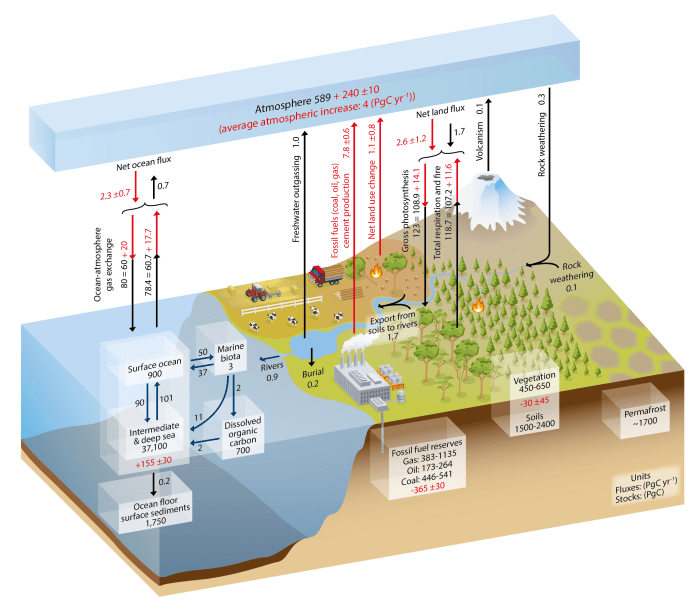Model 2 the carbon cycle answer key – Embark on a journey into the depths of Model 2 of the carbon cycle, a groundbreaking framework that unveils the intricate processes governing the movement of carbon through Earth’s systems. Delve into its assumptions, limitations, and comparisons to other models, gaining a profound understanding of its significance in shaping our planet’s delicate balance.
As we explore the carbon cycle’s interconnected stages, from photosynthesis to decomposition, we uncover the vital role of living organisms in maintaining its equilibrium. We delve into the profound impact of human activities, examining how our actions can disrupt the cycle’s delicate dance, with far-reaching consequences for the stability of our planet’s climate.
Carbon Cycle Overview
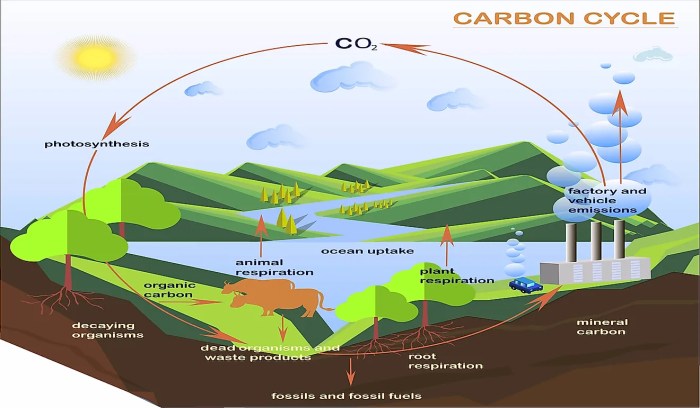
The carbon cycle is a continuous process that involves the exchange of carbon between the atmosphere, hydrosphere, geosphere, and biosphere. Carbon is a fundamental element for all living organisms and plays a crucial role in regulating Earth’s climate.
The carbon cycle comprises several key stages:
- Atmosphere-Biosphere Exchange:Carbon dioxide (CO 2) in the atmosphere is absorbed by plants during photosynthesis, converting it into organic matter.
- Biosphere-Geosphere Exchange:Organic matter from dead plants and animals is buried and converted into fossil fuels over millions of years.
- Geosphere-Atmosphere Exchange:Fossil fuels are extracted and burned, releasing CO 2back into the atmosphere.
- Atmosphere-Hydrosphere Exchange:CO 2dissolves in ocean water, forming carbonic acid and lowering ocean pH.
The interconnectedness of these processes ensures a constant flow of carbon throughout Earth’s systems, influencing the balance of atmospheric CO 2and contributing to the regulation of Earth’s climate.
Model 2 of the Carbon Cycle
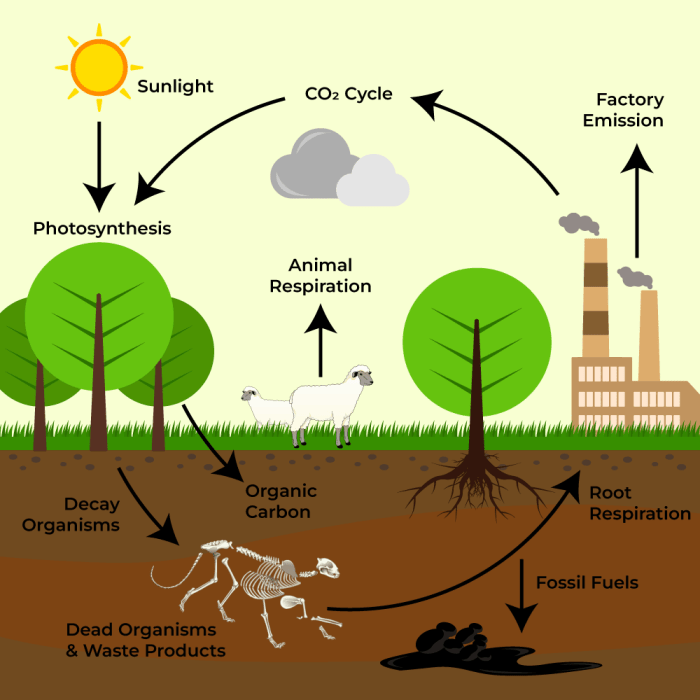
Model 2 of the carbon cycle is a simplified representation of the carbon cycle that focuses on the exchange of carbon between the atmosphere, land, and oceans. It assumes that the carbon cycle is in a steady state, meaning that the amount of carbon entering the atmosphere is equal to the amount of carbon being removed.
This model also assumes that the carbon cycle is primarily driven by photosynthesis and respiration.Model 2 is a useful tool for understanding the basic processes of the carbon cycle. However, it has several limitations. First, it does not take into account the role of human activities in the carbon cycle.
Second, it does not account for the fact that the carbon cycle is not always in a steady state. Third, it does not consider the different timescales of the carbon cycle.Despite its limitations, Model 2 remains a valuable tool for understanding the carbon cycle.
It provides a simple and clear overview of the major processes involved in the carbon cycle and can be used to compare different models of the carbon cycle.
Comparison of Model 2 with Other Models of the Carbon Cycle
Model 2 is one of several models of the carbon cycle. Other models include the Bern Carbon Cycle Model, the Lund-Potsdam-Jena Dynamic Global Vegetation Model, and the Community Earth System Model. These models vary in their complexity and sophistication, but they all share the same basic goal: to represent the carbon cycle in a way that can be used to understand and predict how the carbon cycle will respond to future changes.Model
2 is a relatively simple model, but it is still able to capture the main features of the carbon cycle. It is a useful tool for understanding the basic processes involved in the carbon cycle and can be used to compare different models of the carbon cycle.
Carbon Cycle Processes
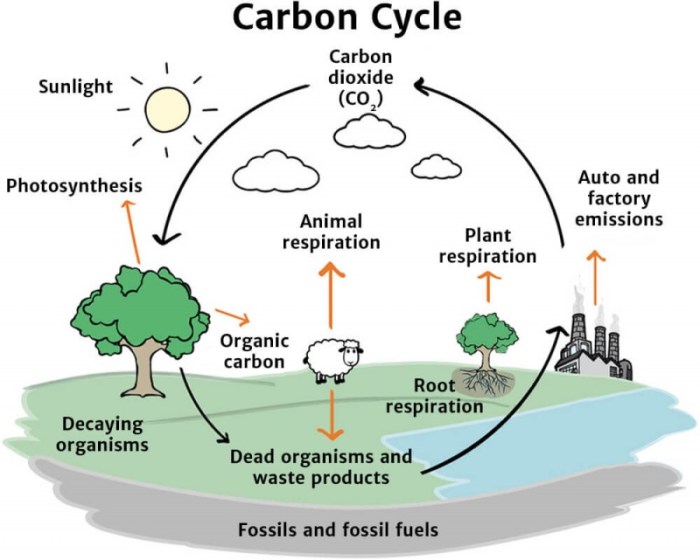
The carbon cycle is a continuous process that involves the exchange of carbon between the atmosphere, oceans, land, and living organisms. The primary processes involved in the carbon cycle are photosynthesis, respiration, decomposition, and weathering.
Photosynthesis
Photosynthesis is the process by which plants and other organisms use sunlight to convert carbon dioxide and water into glucose and oxygen. This process occurs in the chloroplasts of plant cells and is essential for the growth and survival of plants.
During photosynthesis, carbon dioxide is removed from the atmosphere and stored in the form of glucose, which is used as a source of energy by plants and other organisms.
Respiration
Respiration is the process by which organisms break down glucose to release energy. This process occurs in the mitochondria of cells and involves the consumption of oxygen and the release of carbon dioxide. During respiration, carbon dioxide is released back into the atmosphere, completing the carbon cycle.
Decomposition
Decomposition is the process by which organic matter is broken down by microorganisms, such as bacteria and fungi. This process occurs in the soil and water and involves the release of carbon dioxide and other gases into the atmosphere. Decomposition is an important part of the carbon cycle as it helps to recycle organic matter and return carbon to the atmosphere.
Weathering
Weathering is the process by which rocks and minerals are broken down by the action of wind, water, and ice. This process can release carbon dioxide into the atmosphere as carbonates are dissolved in water or broken down by acids.
Weathering is a slow process but can contribute to the carbon cycle over long periods of time.
Role of Living Organisms
Living organisms play a vital role in the carbon cycle. Plants and other organisms remove carbon dioxide from the atmosphere through photosynthesis and store it in the form of organic matter. Animals and other organisms consume plants and release carbon dioxide back into the atmosphere through respiration.
Decomposers break down organic matter and release carbon dioxide into the atmosphere. These processes help to regulate the amount of carbon dioxide in the atmosphere and maintain the balance of the carbon cycle.
Human Activities
Human activities can have a significant impact on the carbon cycle. The burning of fossil fuels, such as coal, oil, and gas, releases large amounts of carbon dioxide into the atmosphere. This can lead to an increase in the concentration of carbon dioxide in the atmosphere and contribute to climate change.
Deforestation can also impact the carbon cycle as trees remove carbon dioxide from the atmosphere and store it in their tissues. The loss of trees can lead to an increase in the concentration of carbon dioxide in the atmosphere.
Carbon Cycle Feedbacks

Feedbacks play a crucial role in regulating the carbon cycle, influencing its stability and global carbon balance. These feedbacks can be either positive, which amplify changes in the carbon cycle, or negative, which counteract them.
Positive Feedbacks, Model 2 the carbon cycle answer key
- Increased atmospheric CO2concentrations lead to enhanced plant growth and carbon sequestration, but also higher temperatures and increased decomposition rates, releasing more CO 2back into the atmosphere.
- Melting permafrostreleases stored carbon into the atmosphere as CO 2and methane, further contributing to global warming and permafrost loss.
Negative Feedbacks
- Increased atmospheric CO2concentrations stimulate plant growth, which removes CO 2from the atmosphere and helps regulate its levels.
- Oceanic uptake of CO2: As atmospheric CO 2increases, the oceans absorb more CO 2, reducing its concentration in the atmosphere.
- Rock weathering: Increased CO 2concentrations in the atmosphere lead to increased weathering of rocks, which consumes CO 2and forms bicarbonate ions.
Influence on Carbon Cycle Stability
Feedbacks can influence the stability of the carbon cycle. Positive feedbacks can amplify disturbances and lead to instability, while negative feedbacks counteract disturbances and promote stability. For example, the positive feedback loop involving increased atmospheric CO 2, plant growth, and decomposition can contribute to the acceleration of climate change.
Conversely, the negative feedback loop involving increased atmospheric CO 2and oceanic uptake of CO 2helps regulate atmospheric CO 2levels and mitigate climate change.
Examples of Feedback Effects on Global Carbon Balance
- The release of carbon from melting permafrost due to positive feedbacks has contributed to increased atmospheric CO 2concentrations and global warming.
- The enhanced plant growth and carbon sequestration resulting from increased atmospheric CO 2have helped mitigate global warming by removing CO 2from the atmosphere.
- The oceanic uptake of CO 2has acted as a significant negative feedback, absorbing a substantial portion of human-emitted CO 2and reducing its impact on global temperatures.
Carbon Cycle and Climate Change: Model 2 The Carbon Cycle Answer Key
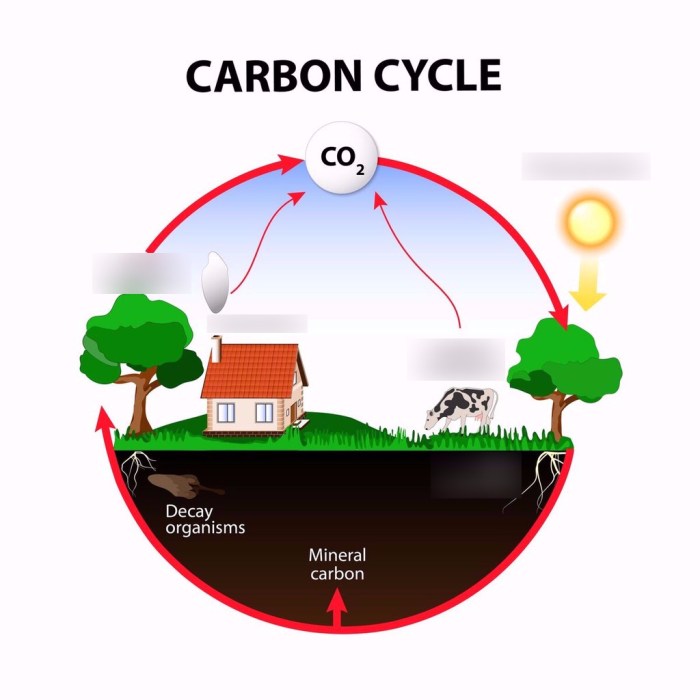
The carbon cycle plays a crucial role in regulating the Earth’s climate. Carbon dioxide (CO 2), a greenhouse gas, is released into the atmosphere through natural processes such as respiration, decomposition, and volcanic eruptions. Human activities, particularly the burning of fossil fuels, have significantly increased the amount of CO 2in the atmosphere, leading to an enhanced greenhouse effect and global warming.
Changes in the Carbon Cycle and Climate
Alterations in the carbon cycle can significantly impact the Earth’s climate. Increased CO 2concentrations in the atmosphere enhance the greenhouse effect, trapping more heat and leading to global warming. This warming can result in various climate change impacts, including rising sea levels, more frequent and intense extreme weather events, and changes in plant and animal distributions.
Evidence of the Carbon Cycle’s Role in Climate Change
Evidence from past and present climate change supports the role of the carbon cycle in regulating the Earth’s climate. Ice core records show that CO 2levels have fluctuated over time, correlating with periods of global warming and cooling. Additionally, the rapid increase in atmospheric CO 2concentrations since the Industrial Revolution has coincided with observed global warming.
Popular Questions
What is the significance of Model 2 in understanding the carbon cycle?
Model 2 offers a detailed and comprehensive representation of the carbon cycle, allowing scientists to simulate and analyze its complex interactions. It provides insights into the behavior of carbon reservoirs and fluxes, aiding in the development of mitigation strategies for climate change.
How does Model 2 compare to other models of the carbon cycle?
Model 2 is more complex and data-intensive compared to simpler models. It incorporates a wider range of processes and reservoirs, resulting in more accurate simulations of the carbon cycle’s dynamics. However, its complexity also requires more computational resources and data, which can limit its accessibility.
